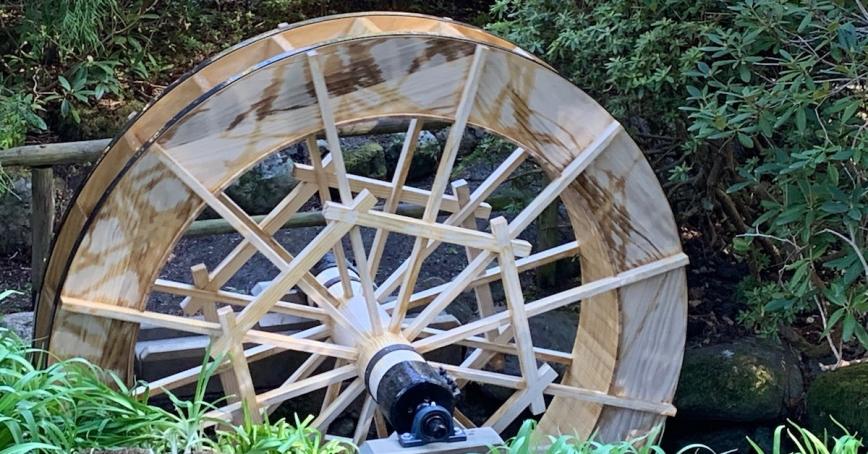Renewal for Royal Roads’ iconic water wheel

Japanese Gardens exude harmony and serenity. From the precise placement of stones to the careful selection and situation of plant groupings, each creation is designed as an oasis of tranquility.
That doesn’t mean the garden is silent. In addition to the chirping of birds and buzzing of insects, there is the gurgling of cool stream water over smooth rocks and, in the case of the garden at Royal Roads University, the gentle scoop and splash of a hundred-year-old water wheel. Created not to power a mill but to provide a soothing sound, the wheel helps fulfill the role of water in the Japanese Gardens, an element of calm, continuity and renewal.
That water wheel, built and installed on a small stream sometime between 1915 and 1930, and repaired more than 20 years ago, needed renewal itself.
Thanks to funding from a variety of donors, the wheel was taken down before Christmas 2020 and sent to Vintage Woodworks Inc. in Saanichton, BC to be rebuilt. It’s the first project of A Vision in Bloom, the Royal Roads fundraising campaign launched this week to restore and maintain the university’s historic gardens.
“It’s going to go back into its home in the Japanese Gardens and it will become a real attraction for visitors,” says Carolyn Levesque, Royal Roads’ Associate vice-president, Operations and Resilience. “That will be quite something, to hear the sound of the water in the garden.”
Jenny Seeman, the university’s archives manager, notes that the original wheel was built of teak and has been repaired a number of times; it was last restored around 1999, when RRU worked with students from Vancouver Island’s Camosun College on the project.
Ken Coley-Donohue’s expert joiners at Vintage Woodworks were most recently tasked with rebuilding the iconic wheel from Royal Roads, which is a National Historic Site. Coley-Donohue, who is the president and owner of the 40-year-old company than handles custom window, door and storefront restorations, says it took four workers about 160 hours using a mixture of modern tools, old-world skills and unique, sustainable materials to recreate the seven-foot-one-inch diameter wheel.
He explains that the previously rebuilt wheel was made mainly of a combination of cedar and white oak. His crew used accoya, a type of pine that is brined and heat treated, without the use of toxic chemicals, to allow for longevity while exposed to the elements. That was crucial, he says, because of Royal Roads’ focus on and dedication to principles of environmental sustainability.
Vintage Woodworks’ ticketed joiners understood how all the pieces needed to go together to reflect the original construction, but they used a new five-axis CNC machine — a computer-controlled precision fabrication device — to cut those pieces based on detailed measurements and instructions they entered into the AutoCAD software.
The final product should last several more decades, Coley-Donohue says.
Ron Granados, Royal Roads’ director of operations, says Vintage’s sustainable approach to this project is consistent with the university’s commitment to the environment. He notes the importance of contributions from Vancouver Island community members to the water wheel restoration as well as the many other works contained in theVision in Bloom campaign aimed at sustaining and maintaining the gardens and grounds.
“It’s important to highlight the beauty of the gardens, the importance to us to maintain the gardens the way they are, and even to improve them,” he says. “But we can’t improve them without community support. Without those donations, the water wheel still would not be repaired.”
The water wheel unveiling is the first project under A Vision in Bloom, which has an initial target of $100,000 to support work on restoring and revitalizing the historic Hatley Park gardens on campus.
Join us to restore garden heritage, build food production or celebrate a friend of loved one in your life.